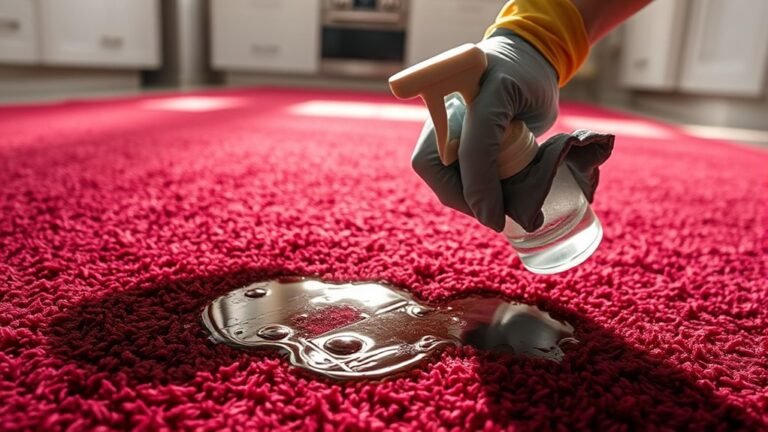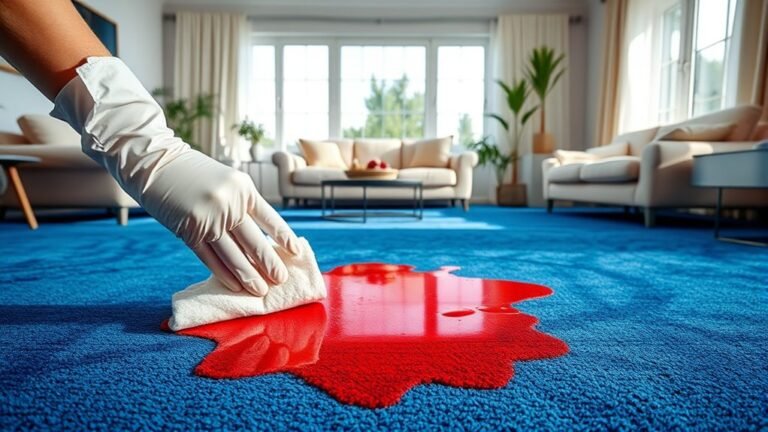Removing Allergens From Sofa Effectively
To remove allergens from your sofa effectively, vacuum it weekly using upholstery and crevice tools to tackle dust mites and pet dander. Use steam cleaning occasionally to kill dust mites deep in the fabric without harsh chemicals, and maintain humidity below 50% to deter allergen growth. Opt for natural, fragrance-free cleaning products and wash sofa covers regularly with hypoallergenic detergents. Taking these steps keeps your sofa fresh and allergen-free—there’s plenty more to explore for a truly allergy-safe home.
Understanding Common Sofa Allergens

Before you can effectively remove allergens from your sofa, it’s important to understand what they are and where they come from. Common allergens like dust mites, pet dander, pollen, and mold spores often hide deep within your sofa materials. Different fabrics and stuffing types trap these irritants differently—natural fibers may hold moisture, encouraging mold, while synthetic ones can collect dust more easily. Knowing which allergens are lurking helps you target your cleaning approach without feeling overwhelmed. You deserve a sofa that’s a sanctuary, not a source of sneezes or discomfort. By understanding common allergens and how your sofa materials influence their presence, you gain the freedom to create a cleaner, healthier living space that supports your well-being every day.
Regular Vacuuming Techniques for Allergen Removal
Regularly vacuuming your sofa is one of the most effective ways to reduce allergens like dust mites, pet dander, and pollen. Using vacuum attachments and upholstery brushes lets you reach deep into crevices and fabric fibers, freeing your space from hidden irritants. Here’s a quick guide to optimize your vacuuming:
| Vacuum Tool | Best For | Frequency |
|---|---|---|
| Upholstery Brush | Fabric surfaces | Weekly |
| Crevice Tool | Sofa seams & corners | Weekly |
| Motorized Brush | Pet hair & dander | Twice a week |
Stick to this routine, and you’ll reclaim fresh, allergen-free freedom in your living space.
Using Steam Cleaners to Eliminate Dust Mites

Using a steam cleaner can effectively kill dust mites hiding deep in your sofa’s fabric without harsh chemicals. You’ll want to follow the manufacturer’s instructions carefully to avoid damaging your upholstery. With proper use, steam cleaning not only reduces allergens but also refreshes your sofa’s appearance.
Benefits of Steam Cleaning
Although dust mites are microscopic, their presence in your sofa can trigger significant allergic reactions. That’s where the steam cleaning benefits truly shine. Using steam cleaning, you can effectively eliminate these allergens without relying on harsh chemicals, giving you freedom from worrying about residue or toxins. The steam cleaning efficiency lies in its ability to penetrate deep into fabric fibers, killing dust mites and neutralizing allergens instantly. Plus, it dries quickly, preventing mold growth. When you opt for steam cleaning, you’re choosing a method that’s both eco-friendly and powerful, ensuring your sofa is not only clean but also healthier for you and your loved ones. Embrace this method, and enjoy the freedom of a fresh, allergen-free living space.
Proper Steam Cleaner Usage
Steam cleaning offers a powerful way to remove dust mites from your sofa, but to get the best results, you need to use the steam cleaner correctly. Start by vacuuming your upholstery to clear loose debris before applying steam. Choose the right steam cleaning techniques—use slow, overlapping passes to guarantee thorough coverage without soaking the fabric. Keep the steam cleaner moving to avoid damage and allow the moisture to evaporate quickly. Focus on high-contact areas where dust mites thrive. After steam cleaning, let your sofa air dry completely to prevent mold growth. Regular upholstery maintenance, including periodic steam cleaning, helps keep allergens at bay and your living space fresh. With the right approach, you’ll enjoy a cleaner sofa and greater freedom from allergens.
Choosing the Right Cleaning Products for Sensitive Skin
When you have sensitive skin, selecting the right cleaning products for your sofa becomes essential to prevent irritation. Harsh chemicals can cause redness, itching, or even allergic reactions. Instead, opt for natural alternatives like vinegar, baking soda, or castile soap, which are gentle yet effective at removing allergens. You’ll want to avoid fragrances and dyes, as they often trigger sensitivity. Always test any product on a small, hidden area first to verify it doesn’t aggravate your skin. Choosing hypoallergenic, eco-friendly cleaners not only protects your skin but also supports a healthier home environment. By being mindful about what you use, you can keep your sofa allergen-free without compromising your skin’s comfort or your freedom to live allergy-free.
Washing Sofa Covers and Cushions Properly

When washing your sofa covers, it’s important to pick detergents that won’t irritate your skin or damage the fabric. You’ll also want to dry cushions properly to prevent mold and maintain their shape. Let’s look at the best detergent options and drying techniques to keep your sofa allergen-free.
Choosing Suitable Detergents
Selecting the right detergent is key to effectively cleaning your sofa covers and cushions without damaging the fabric. You want something gentle yet powerful—enzyme based solutions break down allergens and stains without harsh chemicals. Hypoallergenic detergents are perfect if you’re sensitive or want to keep your space free from irritants.
Here’s a quick guide to help you choose:
| Detergent Type | Best For |
|---|---|
| Enzyme Based Solutions | Removing protein-based stains |
| Hypoallergenic | Sensitive skin, allergy-prone |
| Mild Liquid Detergent | Delicate fabrics |
| Powder Detergent | Heavy-duty cleaning |
| Eco-friendly Options | Sustainable, chemical-free |
Picking the right detergent gives you freedom to clean thoroughly while protecting your sofa’s fabric and your health.
Drying Techniques for Cushions
Properly drying your sofa cushions is essential to prevent mold, odors, and fabric damage. Choosing the right drying methods guarantees effective cushion maintenance and keeps your sofa allergen-free. Here’s how you can dry your cushions like a pro:
- Air Dry Naturally – Place cushions in a sunny, well-ventilated spot to dry evenly without heat damage.
- Use a Fan – Speed up drying by directing airflow across cushions for faster moisture evaporation.
- Avoid Direct Heat – Skip dryers or radiators that can shrink or weaken fabric fibers.
- Flip Regularly – Rotate cushions during drying to maintain shape and guarantee all sides dry thoroughly.
Dealing With Pet Dander on Upholstery
Although pet dander is invisible to the naked eye, it can trigger allergies and make your sofa uncomfortable. To keep your upholstery fresh and allergen-free, regular pet grooming is essential. Brushing your pet reduces loose hair and dander, preventing buildup on your sofa. Combine this with upholstery protection like washable covers or sprays to create a barrier against allergens.
| Action | Benefit |
|---|---|
| Pet Grooming | Reduces dander buildup |
| Upholstery Protection | Blocks allergens |
| Frequent Vacuuming | Removes surface dander |
Implementing Air Purifiers to Reduce Airborne Allergens
When allergens like dust and pet dander linger in the air, an air purifier can make a noticeable difference in your home’s comfort. Choosing the right air purifier types with effective allergen filters helps you reclaim your space and breathe freely. Here’s how to make the most of them:
An air purifier with allergen filters transforms your home’s air, helping you breathe easier and feel more comfortable.
- Select purifiers with HEPA filters, designed to capture tiny airborne allergens.
- Place the purifier near your sofa to target allergens where they settle most.
- Run the purifier continuously or during high-traffic times to maintain clean air.
- Regularly replace allergen filters to keep performance sharp and effective.
Preventative Measures to Keep Allergens Away
To keep allergens from settling on your sofa in the first place, you’ll need to adopt several preventative habits. Choosing allergen resistant fabrics is essential—they repel dust mites and pet dander, making your sofa a less inviting spot for allergens. Pair this with regular maintenance routines like vacuuming with a HEPA filter and spot cleaning spills immediately. These steps guarantee your sofa stays fresh and allergen-free, giving you the freedom to relax without worry.
| Preventative Measure | Benefit |
|---|---|
| Allergen resistant fabrics | Minimizes allergen accumulation |
| Vacuum weekly with HEPA | Removes embedded dust and dander |
| Use washable slipcovers | Easy removal of allergens |
| Maintain humidity below 50% | Reduces dust mite survival |
Stick to these habits for a cleaner, allergen-free sofa.
Frequently Asked Questions
Can Allergen Removal Improve Indoor Air Quality Overall?
Absolutely, removing allergens can boost your indoor air quality greatly. When you tackle allergen sources like dust mites, pet dander, and mold, you reduce indoor pollutants that often trigger allergies and respiratory issues. By keeping your space clean and allergen-free, you’re not just improving air quality—you’re creating a healthier, freer environment to breathe easy and live comfortably without constant irritation or worry.
How Often Should Professional Sofa Cleaning Be Done for Allergy Sufferers?
Funny how your sofa, where you unwind, can also trap allergens that limit your freedom to breathe easy. For allergy sufferers, frequency recommendations often suggest professional cleaning every six months. Using advanced cleaning techniques like steam or dry foam helps deeply remove dust mites and pollen. Sticking to this schedule lets you enjoy your space freely, without sneezing fits holding you back. Keeping your sofa fresh means reclaiming your indoor freedom.
Are Hypoallergenic Sofa Materials Effective Against Allergens?
You might wonder if hypoallergenic fabrics really help with allergen resistance. While they’re designed to minimize allergen buildup, no material is completely allergen-proof. Choosing hypoallergenic sofa materials can reduce dust mites and pet dander, giving you more freedom from constant irritation. Still, regular cleaning is key. So, combining allergen-resistant fabrics with good maintenance lets you enjoy a fresher, more comfortable space without feeling trapped by allergies.
Can Allergens Trigger Asthma Attacks From Sofas?
Did you know that about 60% of asthma attacks can be linked to indoor allergens? Sofa allergens, like dust mites and pet dander, are common asthma triggers you might not expect. If you’re sensitive, these tiny particles can set off attacks, making it harder for you to breathe freely. Keeping your sofa clean and allergen-free helps you reclaim your space and enjoy life without the constant worry of asthma flaring up.
Do Air Humidifiers Help Reduce Sofa Allergens?
You might wonder if air humidifiers can help reduce sofa allergens. While they don’t directly remove allergens, they improve air quality by balancing humidity control. Keeping humidity around 40-50% can prevent dust mites and mold growth, common sofa allergens. So, using a humidifier gives you more freedom to breathe easier and enjoy your space, but it’s best combined with regular cleaning for the most allergy relief.






